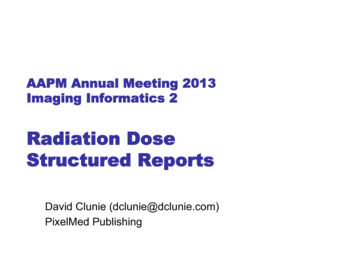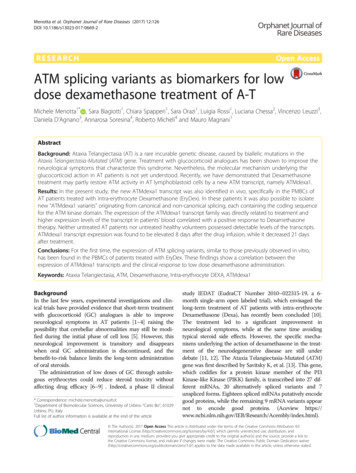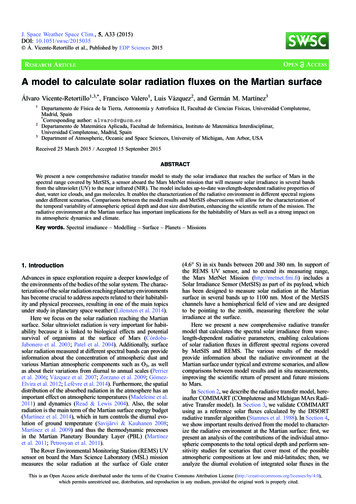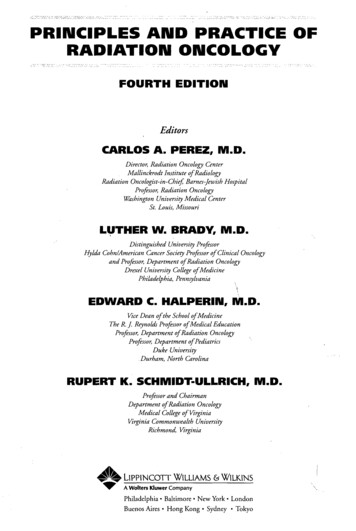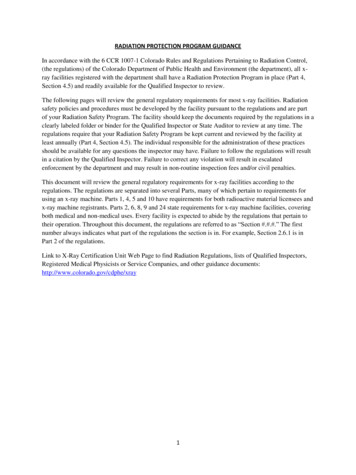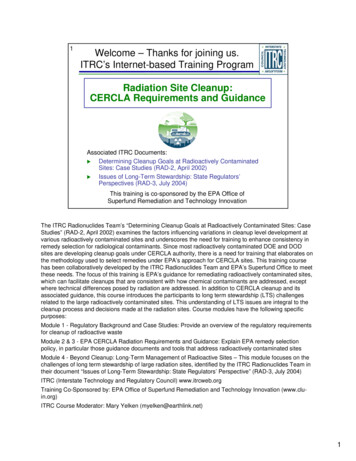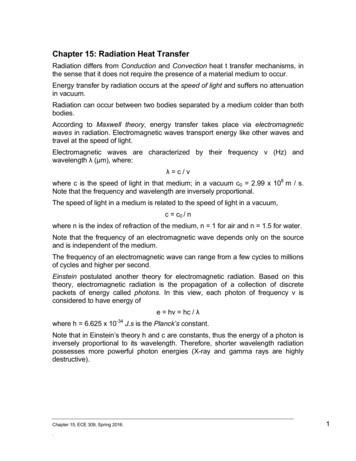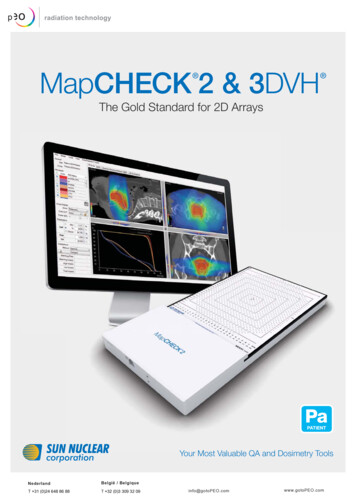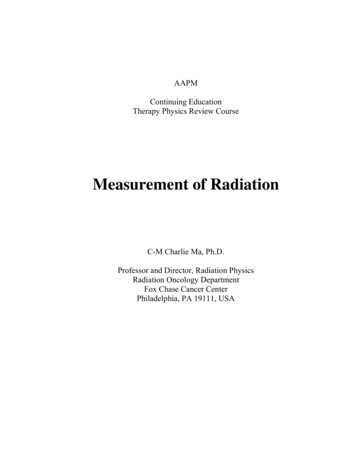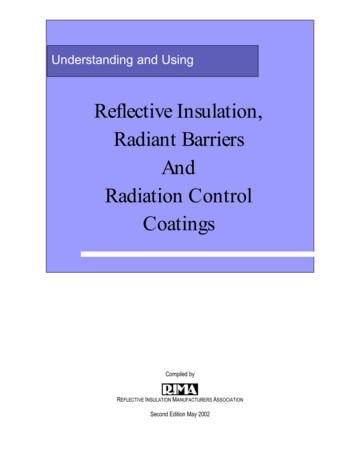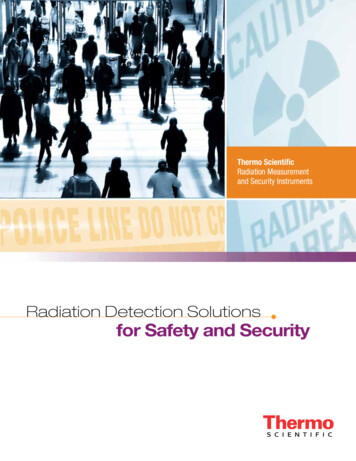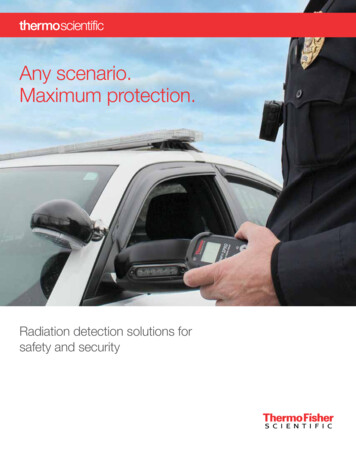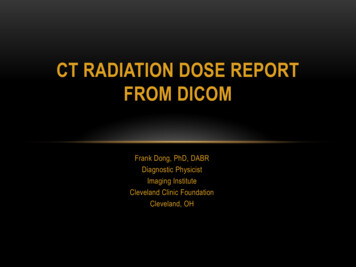
Transcription
CT RADIATION DOSE REPORTFROM DICOMFrank Dong, PhD, DABRDiagnostic PhysicistImaging InstituteCleveland Clinic FoundationCleveland, OH
CTPatient comes out . .Patient goes in . . .BigBlackBoxRadiology reportHx none provided (as usual).Technique: CT abdomen and left kneeFindings: Kjaekjrht ekrhtkje wejkkjsnf.There is nothing to see on this TCbecause the history was useless.Impression: See below. . . with a report!
CT Radiation Dose Reporting California legislation requires CT radiation dose (eitherCTDIvol or Dose Length Product) be included in everyradiology report (Commencing July 1, 2012) Effective July 1, 2016, Joint Commission’s newdiagnostic imaging standards also requiredocumentation of CT dose in patient’s EMR andinterpretive report
Where CT Dose Is Recorded? Dose/protocol page (most common) DICOM Header Radiation Dose Structured Report (RDSR)
CT Dose PageGE scanner
CT Dose PageSiemens scanner
CT Dose PagePhilips scanner
DICOM Standards Digital Imaging and Communication in Medicine(DICOM) is a set of standards developed by theAmerican College of Radiology (ACR) and the NationalElectrical Manufacturer’s Association (NEMA) The aim of DICOM standards is to achieve a high levelof compatibility among imaging systems and otherinformation systems in healthcare environmentsworldwide.
DICOM in a Nutshell DICOM views real-world data, such as patients, studies,and medical devices as objects with attributes. The definitions of these objects are standardized byInformation Object Definitions (IOD) NameIDDOBWeightSexEric Smith12345671968 11 1174M Patient IOD(InformationobjectDefinition)
DICOM in a Nutshell All DICOM attributes are formatted according to 27Value Representation (VR) types Application Entities (AEs): DICOM devices and software AEs provide service to each otherCTU/SReading stationDigital Archive server andsoftware
DICOM in a Nutshell In DICOM, Service-Object Pairs (SOP) associate eachservice type with the data (IODs) that they process DICOM calls the service requestors Service ClassUsers (SCUs) and the service providers Service ClassProviders (SCPs) The imaging device manufacturer’s DICOMconformance statement is the important document tolearn the details and extend of DICOM services thedevice can provide.
Types of DICOM Services DICOM storage CT image storage SOP class DICOM print Basic grayscale print management SOP class (SCU only) Query / Retrieve Query a DICOM device for a list of studies or patients, then retrieve them Worklist Management Download a list of “scheduled procedures” to the modality from the RadiologyInformation System (RIS) through a worklist management provider Modality Performed Procedure Step (MPPS) Modality tells RIS that the procedure has been performed
DICOM Attribute and Tag In DICOM, each attribute of an information object has atag that uniquely identifies itself. The DICOM tag is comprised of two short numbers (inhexadecimal format) called Group and Element. DICOM attributes that are related to each othersometimes share the same group. X-ray tube current (0018, 9930), kVp (0018, 0060) and exposure time(0018, 1030)
DICOM Image Attributes with Tags for CTAcquisition and Dose (Group 0018)Tube Voltage(0018, 0060)tube's kilovoltage peak valueTube Current(0018, 9330)tube current in mARevolution Time in s(0018, 9305)The time in seconds of a complete revolution of the source around thegantry orbitExposure Time in ms(0018, 9328)Duration of exposure fr this frame in milliseconds.Exposure in mAs(0018, 9332)Total Collimation width(0018, 9307)Single Collimation width(0018, 9306)The exposure expressed in milliampere seconds (mAs mA*revolutiontime in seconds)The width of the total collimation (in mm) over the area of active x-raydetection.The width of the single row of acquired data (in mm). Note: adjacentphysical detector rows may have been combined to form a singleeffective acquisition row.CTDIvol(0018, 9345)Volume CT Dose Index averaged at specific slice locationCTDI Phantom Type Code Sequence(0018, 9323)The type of phantom used for CTDI measurementData collection diameter(0018, 0090)The diameter in mm of the region over which data were collected.Spiral Pitch Factor(0018, 9311)Ratio of the Table Feed per Rotation to the total collimationTable Feed per rotation(0018, 9311)Motion of the table (in mm) during a complete revolution of the sourcearound the gantry orbitExposure Modulation type(0018, 9323)A label describing the type of exposure modulationScan Length(0018, 1302)Size of the imaged area in the direction of scanning motion, in mm
DICOM Tag As a convention, DICOM tags with even group numbersare reserved for standard use. All old group numbers are reserved for private use, or“private tag”. Dose Length Product (DLP) doesn’t have a standard tagassigned. Therefore, it is treated as a private tag. Vendor’s DICOM Conformance Statement may be ableto provide the “private” tag number for DLP. Such asPhilips uses the private tag (00E1,1021) for DLP.
Extracting CT Dose from Dose Page orDICOM Header For CT scanners with only dose page, one typicallyuses Optical Character Recognition (OCR) software toextract numbers representing CTDIvol or DLP. For all “newer” scanners, CT vendors have adoptedDICOM standards and the radiation dose relatedattributes at the series and image level. Dose valuescan be extracted electronically from DICOM attributes. Most commercially available software uses bothapproaches for hospitals with mixed generation ofscanners.
Limitations with OCR and DICOM Headers OCR software is sensitive to the resolution and/orcontrast (ww and wl settings) of the dose page. Change to the character location may also impact theaccuracy of OCR. Image-based DICOM header may have duplicated dosevalue if the image is “derived” from the original, i.e.,reconstructed with different kernel or thickness. Some radiation exposure events may not be captured ifthe images resulting from these events are notreconstructed or forwarded from the scanner.
Which one is not part of theservices DICOM rieveWorklist ManagementImage SegmentationModality Performed Procedure Steps10
Which one is not part of the services ist ManagementImage SegmentationModality Performed Procedure StepsAnswer is 4. DICOM provides storage, query/retrieve, WorklistManagement, and MPPS, but not Image Segmentation.Reference: Oleg S. Pianykh, “Digital Imaging and Communications inMedicine: A practical Introduction and Survival Guide”. 2nd Edition.
Radiation Dose Structured Report (RDSR) Compared to the does page and DICOM header, RDSRis a much better way to capture and store radiationexposure related information. CT Dose SR is described in detail by DICOMSupplement 127: CT Radiation Dose Reporting (DoseSR) CT Dose SR is one of four requirements for CTequipment to meet (NEMA-XR-29) by January, 2016, inorder to avoid 5% penalties in technical component ofreimbursement by Medicare, and penalties rise to 15%in 2017 and thereafter.
What is RDSR? RDSR is a member of more extensive DICOMStructured Report (SR) family In a simple term, RDSR is a “dose report” with“structure”. Here, “structure” means a “content tree”: a large amountof information organized in a tree-like structure. For CT, the contents have three parts: 1) the DICOMheader; 2) the dose accumulation container; 3) thecontainer holding the information for each irradiationevent.
What is a Dose SR Template? In CT Dose SR, a Template Identifier (TID) is used tohelp organize the structure and specify the rules.CT Radiation Dose SR IOD Template Structure
CT Irradiation Event template (TID10013) Acquisition protocol Target region CT Acquisition type Procedure Context Irradiation Event UID Exposure Time Scan Length Normal Single Collimation Width Pitch Factor Number of X-ray Sources Identification of the X-ray Source KVP Maximum X-ray Tube Current X-ray tube current
TID10013 (cont.) Exposure Time per Rotation X-ray Filter Aluminum Equivalent Mean CTDIvol CTDI w Phantom Type CTDI free air Calculation Factor Mean CTDIfree air DLP Effective Dose Measurement method Effective Dose Conversion Factor CT Dose Check Details X-ray Modulation Type Person Participant Device Participant
RDSR as a Content Tree
A RDSR Viewer Most PACS systems rarely have correct SOP class tosupport CT Dose SR object, therefore, a separateserver is needed to receive and parse these encodedRDSR objects into a plain text. Every vendor of Dose SR viewer provides reports thatdiffer in appearance and format of dose relatedinformation. DoseUtility from PixelMed [1] is a useful open sourceRDSR reader which is Java-based and easy to use. A recently published and also free RDSR reader isOpenREM [2]
RDSR Converted toplain text format
Verification of RDSR To turn CT RDSR on, check with vendor for the softwarerevision number with RDSR capability To verify the Dose SR is correctly generated:1)Setup a DICOM SCP node on a computer2)Configure the CT scanner to send the CT Dose SR to that node3)Using a RDSR reader (such as DoseUtility or OpenREM) toconvert the Dose SR into a plain text file4)Verify the dose and/or acquisition related parameters areconsistent with vendor’s DICOM Conformance Statement andthe actual dose and acquisition parameters displayed on thescanner
CT Dose SR uses which of the following toorganize the structure and specify the rules?20%20%20%20%20%1.2.3.4.5.DICOM TagDICOM AttributeService Object Pairs (SOP)Information Object DefinitionTemplates (TID)10
CT Dose SR uses which of the following toorganize the structure and specify the rules.1.2.3.4.5.DICOM TagDICOM AttributeService Object Pairs (SOP)Information Object DefinitionTemplates (TID)Answer is 5. CT Dose SR uses Template Identifier (TID) to organizethe structure and specify the rules.Reference: DICOM Supplement 127: CT Radiation Dose Reporting (Dose SR).
Current CT Dose SR Is IncompleteInformation is important to patient dose estimate but stillmissing from RDSR:1)Parameters for tube current modulation: ref. mAs, Noise Index,Min and Max mA2)Actual tube current at different view angles.3)Parameters for iterative reconstruction: IR strength4)SSDE or WED at various patient longitudinal positions5)Patient centering, arm positioning and relative anatomicalposition.
Conclusions Dose reporting is an important part of CT qualityassurance and patient safety program. To better estimate patient specific dose from CT scan,acquisition parameters and patient related informationare necessary. DICOM CT Radiation Dose SR plays a vital role forboth dose reporting and patient specific dose estimate. Future enhancement to CT RDSR is also needed.
01.07.2012 · DICOM attributes that are related to each other sometimes share the same group. X-ray tube current (0018, 9930), kVp (0018, 0060) and exposure time (0018, 1030) DICOM Image Attributes with Tags for CT Acquisition and Dose (Group 0018) Tube Voltage (0018, 0060) tube's kilovoltage peak value Tube Current (0018, 9330) tube current in mA Revolution Time in s (0018, 9305) The time in .
